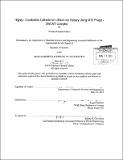| dc.contributor.advisor | Angela Belcher. | en_US |
| dc.contributor.author | Adams, Melanie Chantal | en_US |
| dc.contributor.other | Massachusetts Institute of Technology. Department of Materials Science and Engineering. | en_US |
| dc.date.accessioned | 2013-09-24T19:45:16Z | |
| dc.date.available | 2013-09-24T19:45:16Z | |
| dc.date.copyright | 2013 | en_US |
| dc.date.issued | 2013 | en_US |
| dc.identifier.uri | http://hdl.handle.net/1721.1/81137 | |
| dc.description | Thesis (S.B.)--Massachusetts Institute of Technology, Dept. of Materials Science and Engineering, 2013. | en_US |
| dc.description | Cataloged from PDF version of thesis. | en_US |
| dc.description | Includes bibliographical references (p. 27). | en_US |
| dc.description.abstract | Lithium-ion batteries are commonly used in portable electronics, and the rapid growth of mobile technology calls for an improvement in battery capabilities. Reducing the particle size of electrode materials in synthesis is an important strategy for improving their rate capability and power density (which is the capacity at high rates). Using biological materials as a template during synthesis allows us to achieve this, improving synthesis methods. Utilizing biological materials makes it possible to synthesize nano-scale particles, and using the M13 virus has shown to be an early solution. The addition of conductive material, such as single-walled carbon nanotubes (SWCNT or CNT), also improves the conductivity of the electrode, further improving the battery's rate capabilities (Lee et al., 2009). In this study, our goal is to improve the conductivity of the LIB battery cathode using M13-carbon nanotube complexes. | en_US |
| dc.description.statementofresponsibility | by Melanie Chantal Adams. | en_US |
| dc.format.extent | 27 p. | en_US |
| dc.language.iso | eng | en_US |
| dc.publisher | Massachusetts Institute of Technology | en_US |
| dc.rights | M.I.T. theses are protected by
copyright. They may be viewed from this source for any purpose, but
reproduction or distribution in any format is prohibited without written
permission. See provided URL for inquiries about permission. | en_US |
| dc.rights.uri | http://dspace.mit.edu/handle/1721.1/7582 | en_US |
| dc.subject | Materials Science and Engineering. | en_US |
| dc.title | Highly - conductive cathode for lithium-ion battery using M13 phage - SWCNT complex | en_US |
| dc.title.alternative | Highly-conductive cathode for lithium-ion battery using M13 phage - single-walled carbon nanotubes complex | en_US |
| dc.type | Thesis | en_US |
| dc.description.degree | S.B. | en_US |
| dc.contributor.department | Massachusetts Institute of Technology. Department of Materials Science and Engineering | |
| dc.identifier.oclc | 858281521 | en_US |
